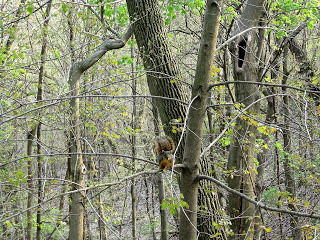We Are Trees
 Tiny buds on the trees are giving the woods behind my house a light green sheen.
Tiny buds on the trees are giving the woods behind my house a light green sheen.Last week I noticed a beautiful bare tree. Without any leaves, its entire structure was visible —the trunk, main branches, even the smaller branches as they tapered out into thousands of tiny fingers. The tree was so symmetrical that I gazed at it in admiration, and then I had to leave because I was in a car at a stoplight.
We are like trees.
We grow out from where we’ve been.
The root systems of many trees are a mirror image of what we see in their branches. The half of the tree that branches underground provides nourishment, while the top half we see does something.
Trees are half contemplation, half action.
A few days ago I went into the woods and found a favorite tree that did not survive the winter. The bark on my old friend was beginning to come off in places. I’ve enjoyed the beauty of this tree over the years, and sat under it when it was full and glorious in its summer green. In blustery thunderstorms, I’ve watched it sway back and forth in the wind.
When we sit in a forest and watch the trees, we nourish our roots.
A hole in the trunk of another tree has become a new home for squirrels. I think the trunk might be hollow. Soon its branches will let go under their own weight, and the tree will fall. Then it will become a home for insects and grubs, and attract a new set of birds. Its body will be reabsorbed into the earth and nurture the next generation.
Some trees have significance larger than our personal delight, like the cedars of Lebanon, the giant sequoias of Yosemite, the Bodhi Tree of Buddha, and the Glastonbury Thorn.
When any noble tree dies, I mourn its passing.
Published on April 10, 2016 06:41
No comments have been added yet.



